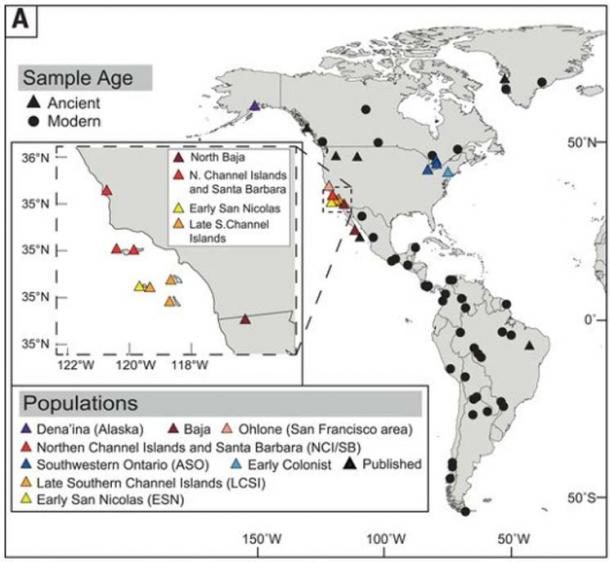
© Page Museum/Travis S./CC BY-NC 2.0First Americans, photo of mural in the Page Museum, Los Angeles
A new genetic study of ancient individuals in the Americas and their contemporary descendants finds that two populations that diverged from one another 18,000 to 15,000 years ago remained apart for millennia before mixing again. This historic "re-convergence" occurred before or during their expansion to the southern continent.
The study, reported in the journal
Science, challenges previous research suggesting that the first people in the Americas split into northern and southern branches, and that the southern branch alone gave rise to all ancient populations in Central and South America.

© C. L. Scheib et al, SciencemagAncient individuals, population genetic analyses and modeling. ( A) Sites of newly sequenced ancient individuals are designated by colored triangles. Comparative modern populations and ancient individuals are designated by black circles and triangles, respectively.
The study shows for the first time that, deep in their genetic history, many Indigenous people in the southern continent retain at least some DNA from the "northerners" who are the direct ancestors of many Native communities living today in the Canadian east.
"It was previously thought that Indigenous South Americans, and indeed most Native Americans, derived from one ancestry related to the Clovis people, who lived about 13,000 years ago," said Cambridge University archaeology professor Toomas Kivisild, who co-led the research with University of Illinois anthropology professor Ripan Malhi.
Read the article
here.





Study - Humans were in America 100,000 years earlier than we thought. - By Gisela Crespo, CNN, April 26, 2017.
The only humans who could have been there 130,000 BC, would have been Afruikans. And yes, the portrait from the French guy shows Afruikans.
That also brings to mind the question of Native Americans, when the earliest the indians could have there was around 20,000 years ago.
Shalom